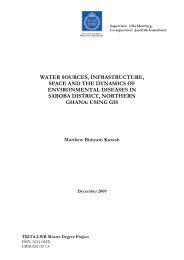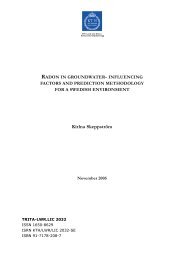Comparison between 1D and 2D models to analyze the dam break
Comparison between 1D and 2D models to analyze the dam break
Comparison between 1D and 2D models to analyze the dam break
- No tags were found...
Create successful ePaper yourself
Turn your PDF publications into a flip-book with our unique Google optimized e-Paper software.
Ignacio Valcárcel LencinaTRITA LWR Masters ThesisFigure 4. The Scalar Expressions dialog box.3.5 Geometry.To create <strong>the</strong> <strong>1D</strong> geometry model, a line which is 100m in length has been drawn. This is <strong>the</strong> first step <strong>to</strong> doonce <strong>the</strong> dimensions <strong>and</strong> <strong>the</strong> dependant variables havebeen chosen. The figure below show <strong>the</strong> <strong>1D</strong> geometrymodel:Figure 6. Bathymetry profile, z f , used in <strong>the</strong> model.Figure 7. The initial water surface profile <strong>and</strong> <strong>the</strong>bathymetry profileFigure 5. <strong>1D</strong> geometry model3.6 Bathymetry profile.As it was written previously, <strong>the</strong> bed profile z f hasbeen defined in this way:z f = (0)*(x=52)In <strong>the</strong> figure below we can see <strong>the</strong> sinusoidal bedprofile only downstream of <strong>the</strong> <strong>dam</strong>, <strong>the</strong> zone ofinterest for us hydrodynamically speaking (notice <strong>the</strong>difference in scale <strong>between</strong> <strong>the</strong> x <strong>and</strong> y direction). Thiskind of profile is <strong>the</strong>oretical, but <strong>the</strong> purpose here isshowing <strong>the</strong> influence of <strong>the</strong> <strong>to</strong>pography of <strong>the</strong> bed on<strong>the</strong> elevation of <strong>the</strong> water surface. To see thisinfluence, <strong>the</strong>se small elevations of 10 cm have beenintroduced. A higher elevation profile has moreinfluence on <strong>the</strong> water surface, but it introduces muchmore instabilities in <strong>the</strong> model.3.7 Initial value.For a time-dependent analysis, initial conditions mustbe provided. An initial value for each dependentvariable is entered. We can also enter initial values for<strong>the</strong> first time derivative of <strong>the</strong> dependent variables.These are used when solving time-dependentproblems containing second time derivatives. In thiscase <strong>the</strong>re are no second time derivatives, <strong>the</strong>n weenter zero in both edit fields.Only one value different from zero in <strong>the</strong> first editfield is entered, for <strong>the</strong> dependent variable z. Thisvalue is equal <strong>to</strong> z 0 because it was defined previously in<strong>the</strong> scalar expressions [3.4]. At t=0 <strong>the</strong> value of <strong>the</strong>o<strong>the</strong>r dependent variable zv is equal <strong>to</strong> zero.The figure 7 above shows clearly <strong>the</strong> situation at t = 0,before <strong>the</strong> <strong>dam</strong> <strong>break</strong> occurs.The expression for <strong>the</strong> initial value is:z 0 = (10)*(x=50).8
















